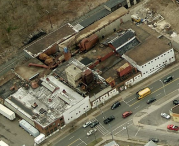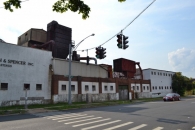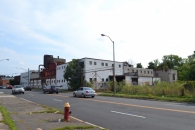Mill Record Hartford
RETURN TO ‘FIND MILLS’Disclaimer: Content for these properties was compiled in 2014-2017 from a variety of sources and is subject to change. Updates are occasionally made under Property Information, however the Connecticut Trust for Historic Preservation (dba Preservation Connecticut) makes no representation or warranty that the information is complete or up-to-date.
- Complex Name (Common)
- Philbrick-Booth and Spencer Co. DEMO’d 2018
- Complex Name (Historic)
-
- Philbrick-Booth and Spencer Co.
- Address or Location
- 367 Homestead Avenue, Hartford
- County
- Hartford
- Historic Designation
- Associated Mill Community
- n/a

- Historic Information
Companies Associated w/Complex
- Philbrick-Booth and Spencer Co. Inc. 1927-ca. 2000
- Philbrick-Booth Co. 1916-1927
Use (Historic)
Largest Documented Workforce
50-99 (1939).
Historic Narrative
The Philbrick-Booth and Spencer Company was originally organized in Hartford, Connecticut as the Philbrick-Booth Company in 1916. The firm was established for the production of iron castings and the original partners consisted of Major Halsey B. Philbrick and his son Halsey R. Philbrick, both of Hartford, and Thomas T. Booth, of Worcester, Massachusetts. The senior Philbrick, a Civil War veteran, was a building contractor by trade and served as Hartford’s first selectman from 1903-1918, while his son was trained as an electrical engineer. Booth, on the other hand, had extensive experience in the foundry business and was undoubtedly drawn into partnership with the Philbricks due to the fact that Halsey R. Philbrick had married his only daughter in 1909. The firm was established with $15,000 in capital and moved quickly to erect a new plant on Homestead Avenue in Hartford in the summer of 1916. The Philbrick-Booth and Spencer Company’s foundry was completed in September 1916 and its 60 initial employees immediately found themselves busy in an environment in which Hartford’s other foundries could not keep up with demand, thus forcing many local manufacturers to look to cities such as Willimantic, Meriden, Waterbury, and Bristol, Connecticut; Springfield, Massachusetts; and Saratoga Springs, New York. The new plant was noted for its modern design at the time of its completion and many of its operations took advantage of electrical power wherever possible. Such technologies included electric-powered blast furnaces, compressed air-driven Whiting traveling cranes (these with a maximum capacity of 15,000 pounds), electric chisels and lighting, and compressed air sand blasting machinery. The plant’s Taxson design cupola had a melting capacity of ten tons per hour and both finished and raw materials were all moved by crane or electric railway. The business and its foundry were expanded several times during the 1910s and 1920s, and in 1927 the firm merged with the Hartford Foundry Company of Wethersfield, Connecticut, to form the Philbrick-Booth and Spencer Company. The origins of the Spencer name came from the new partner, Edgar B. Spencer, who had organized that firm in 1926. During the middle of the twentieth century the company remained profitable through specialization in the manufacture of castings for airplane engines and submarine parts, while its primary contribution during the Second World War was the production of grenade casings. During the Space Race, the firm even produced a cast cover used on a fuel cell module. The Philbrick-Booth and Spencer Company continued to employ roughly 50 employees into the 1990s. The firm closed its doors around 2000 and the plant is now vacant, although brownfield remediation has recently taken place on the site.
- Architectural Information
Number of Existing Buildings
Roughly ten (10) primary adjoining primary blocks.
Dates of Construction
1916, ca. 1920, 1927, ca. 1930, ca. 1960.
Architect
n/a
Builder
n/a
Building Type
Architectural Description
The former Philbrick-Booth and Spencer Company foundry is comprised of a cluttered amalgam of roughly ten primary adjoining blocks located on the south side of Homestead Avenue, opposite Homestead Avenue’s intersection with Kent Street. The oldest portion of the foundry was built in 1916 and is currently located at the core of the plant. The original building measured roughly 105’ x 95’, however, numerous additions adjoining all sides have obscured the original footprint and resulted in an overall complex measuring approximately 244’ x 175’. The one-and-a-half-story foundry building is of red brick construction and has two tall clerestory monitors running along its ridgeline. A two-story stuccoed façade was erected at some point during the mid-twentieth century, this largely obscuring the block’s original profile. The façade is painted white and has small rectangular window openings and metal lettering above that reads, “PHILBRICK-BOOTH and SPENCER, INC./STEEL CASTINGS.” A one-story red brick ell extends to the north linking the original block to additions erected during the 1930s, 1950s, and 1960s. The façade shows the block’s brick pier construction, however, the large window openings have been reduced in size, likely when the modern façade was added to the main foundry building as it is of similar materials and styling. A two-story, 38’ x 26’ red brick block at the southeast corner of the plant replaced an earlier one-story frame building around 1927. The block is of brick pier construction and is five bays wide and three bays deep. It has a raised concrete foundation, large window openings with detailed brick sills and lintels, multi-pane metal sash with hopper-style openings, and a flat roof. The building housed the company’s offices and was the location of the main entrance to the plant. A transom above the entry bears gilt lettering that reads, ““PHILBRICK-BOOTH/and/SPENCER,” while a round plaque above the door bears a large letter “S.” The remainder of the plant is comprised of a visually haphazard collection of one- and two-story blocks of brick, frame, steel, and concrete construction. Steel-frame conveyors span from building to building and a variety of ventilators and exhaust chimneys rise from roofs throughout the plant.
Exterior Material(s)
Structural System(s)
Roof Form
Roof Material
Power Source
Condition
Deteriorated
Condition Notes
The complex is in deteriorated condition. Many of the exterior walls are in need of cleaning and repairs, and some of the roofs show signs of failure. DECD awarded a $1.9 million grant to demolish and remediate 367, 393 & 424 Homestead Avenue Nov 2017.
- Property Information
-
Specific Location
One legal parcel (367 Homestead Avenue) totaling 1.26 acres located on the south side of Homestead Avenue, opposite Homestead Avenue’s intersection with Kent Street.
Adjacent To
Exterior Visible from Public Road?
Yes
Parcel ID / Assessor Record Link
- 153/181/6 (for record, use link and type in address or parcel number) / Link →
Acreage
1.26
Use (Present)
- Sources
-
Form Completed By
Lucas A. Karmazinas
Date
08/13/2015
Bibliography
- List of Connecticut Manufacturers, 1922, 1924, 1930, 1932.
- Directory of Connecticut State Manufacturers, 1936, 1939.
- Industrial Directory of Connecticut, 1947.
- Register of War Production Facilities in Connecticut, 1951.
- Map of Hartford County, H & C.T. Smith, 1855.
- Atlas of Hartford County, Beers, Baker & Tilden, 1869.
- Sanborn Map Company, 1885, 1900, 1917, 1920, 1923, 1950.
- Aerial Survey of Connecticut, 1934, 1965.
- Hartford City Directories, Various editions.
- The Hartford Courant, 1916, 1922, 1927, 1998.
- Representative View(s)Click on image to view full file








